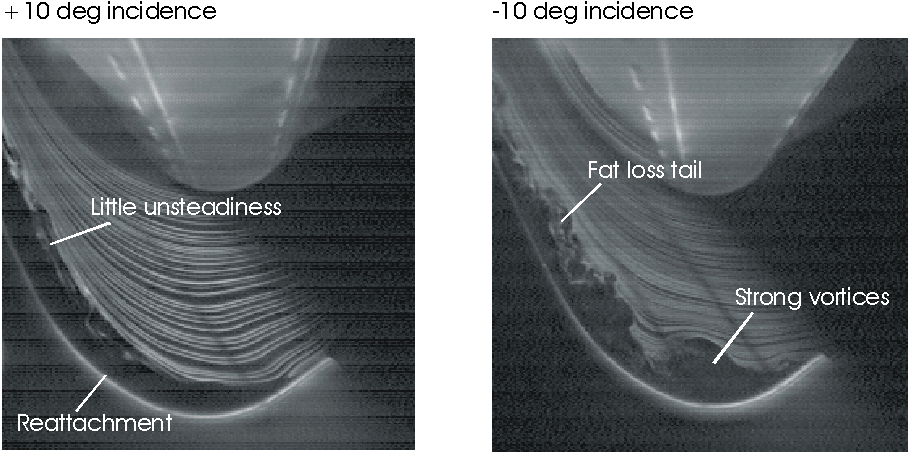Howard Hodson's Current Research
Tip Leakage Flows in Radial Inflow Turbines
Research aimed at understanding the nature of tip clearance flow in radial inflow turbines has established three regions of different tip leakage flow behaviour. The first two region in the inducer and midsection present a very different tip leakage pattern compared to axial turbines. It was found that existing tip leakage models for axial turbomachinery can not simply be applied to radial turbomachinery. Aspects of tip gap flow field and loss production are being studied in a combined experimental and numerical approach. The understanding is focused on the so called scraping effect and its influence on the loss mechanism in the inducer. A tip leakage mass-flow model for radial turbines is being developed and will be validated against detailed measurements in the tip gap.
Howard Hodson, (Roger Dambach)
|
|
|
|
Flow visualisation in the tip gap region of a radial inflow turbine |
Relative velocity vectors in the tip gap of the inducer of a radial inflow turbine |
Wake-Boundary Layer Interactions in Low Pressure Turbines
Research into the benefits of incident wakes on the boundary layers and separation bubbles of highly loaded low pressure turbines continues. Past work has lead to improvements in blade lift coefficients and also to an improved understanding of the unsteady transition processes on suction surfaces. Further improvements in lift coefficients have recently been obtained. This was possible due to a greater understanding of wake - boundary layer and separation bubble interactions, which now allow blade designs with less turbulent flow on the blade surface. Current experimental work aims to look in greater detail than previously possible at the interactions of wakes and separation bubbles. A flat plate rig allowing a variety of imposed pressure gradients has been constructed for this purpose. The experimental results will be incorporated into theoretical models of transition. It is envisaged that this approach will lead to a CFD code that is able to predict the time history of transitional boundary layer development in an unsteady wake environment. This in turn will help to guide the future direction of experiments, research and design. These experiments will be conducted in a large scale low speed cascade and in a transonic facility both fitted with wake generation mechanisms
Howard Hodson, O.N. Ramesh, Robert Howell
|
|
Multi-element hot film sensors fitted to a BMW Rolls-Royce low pressure turbine blade segment |
Pressure Surface Separation Bubbles in Low Pressure Turbines
In order to reduce the weight and cost of modern civil aircraft engines, manufacturers often use thin, solid blades in the LP turbine. These blades commonly have a velocity 'spike' near the leading edge and an adverse pressure gradient along the pressure surface fore-blade. Under these conditions, the pressure surface boundary layer may separate near the leading edge and reattach as far back as mid-chord. The resulting separation bubble can be strongly unsteady and contribute significantly to the loss generated by the blade.
The behaviour of these bubbles has been studied in detail in a steady inflow, linear cascade. This has revealed a number of interesting phenomena and suggests that these bubbles behave in a manner that is similar to leading edge separation bubbles on axial compressor blades. In particular, the behaviour of the pressure surface separation is strongly dependent on incidence; as incidence is reduced the bubble increases in size, tends to transition more violently and produces more loss. The instability mechanism(s) leading to transition also appear to vary with incidence.
Other work has shown that the interaction between the pressure surface separation and the secondary flow is also a significant loss producing mechanism. Current research is extending this investigation to conditions more representative of that in an engine by including wake passing and a radial pressure gradient.
Howard Hodson (Michael Brear)

Smoke wire visualisation of the pressure surface separation at different incidences
Steady and Unsteady Steam Turbine Blade Aerodynamics
Steady and unsteady Flow Phenomena with respect to Steam Turbine Reaction Blade Aerodynamics are being investigated. The current research activity is being undertaken on a Low Speed Research Turbine Facility. State of the art 3D concepts have been employed for the design of the low aspect ratio turbine blading. Performance studies will be carried out on single and two stage turbine configuration. The experimental investigation is being complemented by 3D flow calculations. Extensive unsteady flow phenomena investigation including, wake-blade interaction, shroud leakage flow phenomena and vortex transport in the blade passage will be carried out at a later stage of this project. The current research activity is supported by Mitsubishi Heavy Industries of Japan.
Howard Hodson, Anestis Kalfas (Siva Prasad)
|
|
|
|
|
Rotor assembly |
|
Rotating traverse gear |
|
|
|
|
|
Rotor shroud leakage path |
|
Detail of rotor shroud |
Turbulence Modelling in Unsteady Flows in Axial Flow Turbines
The interactions of wakes with succeeding blade rows have received much attention in recent years. The objective of much of this work has been to study the effects of the wakes on boundary layer transition. This is because the most significant effect is the periodic forcing of the transition of the blade surface boundary layers and the influence this has upon the aerodynamic and thermodynamic performance of the blade row. However, insufficient emphasis has been placed on the changes which take place in the wake as it moves through the downstream bladerow. Partly because of this, it is impossible to predict the onset of transition in wake-affected boundary layers. This work aims to study the development of the flow in the passage of an axial turbine cascade subject to incoming unsteady wakes and its interaction with the (unsteady) flow on and near the surfaces of the blades under investigation and so fill an existing gap. The project is sponsored by the BRITE-EURAM program.
|
|
Moving bar cascade |
Home | Current Research | Research Opportunities
Publications | Staff and Students
Research Facilities | Travel Information | Contact Information | Links